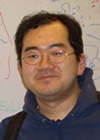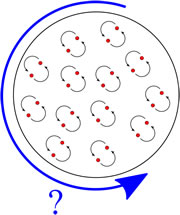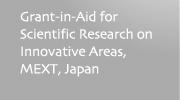
Masaki Oshikawa
Professor, Institute for Solid State Physics, University of Tokyo Condensed Matter Theory, Statistical Mechanics- Topics of Research:
- Elucidation of Intrinsic Angular Momentum and Edge Currents in Chiral p-wave Superfluids
■ Laboratory Website
■ Description of Research [1289KB]
[1289KB]
RESEARCH
My research interest has been in problems in condensed matter physics, which are related to fundamental issues in statistical mechanics. Much of my work is indeed related to topological aspects of condensed matter physics. Back in 1992, I have generalized "hidden Z2 X Z2 symmetry" found by Kennedy and Tasaki for S = 1 chain, to spin chains with general integer spin S. It was found unexpectedly that the hidden symmetry is broken spontaneously in "Haldane phase" for odd integer S, but unbroken for even integer S. Although it was not recognized at that time, the Haldane phase for odd integer S turned out to be an example of "symmetry-protected topological phase", the concept established following the discovery of topological insulators. In recent papers, we elucidated the symmetry-protected topological phase in spin chains, and demonstrated that the Haldane phase for even integer S is indeed trivial.
 Figure: Is the total angular momentum of a chiral superfluid given by assuming all the fermions form Cooper pairs?
Figure: Is the total angular momentum of a chiral superfluid given by assuming all the fermions form Cooper pairs?
Topological order is another important concept, originally conceived based on fractional quantum Hall states. Its signature is topological ground-state degeneracy. Unlike a ground-state degeneracy due to a spontaneous symmetry breaking, it depends on the topology of the space on which the system is defined. Moreover, the degenerate ground states cannot be distinguished by any local order parameter. We have clarified the relation between the topological ground-state degeneracy and fractionalization: under rather general conditions, the fractionalization requires topological ground-state degeneracy. These concepts are of a renewed interest, for further development of topological phases in strongly correlated systems.
In my two years of participation in this project, my main goal is to clarify the issue of intrinsic angular momentum in chiral superfluids. For example, let us consider a chiral p-wave superfluid. Since each Cooper pair carries angular momentum 1, the total angular momentum of N fermions would be expected to be N/2. On the other hand, however, usually the pairing gap is much smaller than Fermi energy. This implies that only the fermions near the Fermi surface, suggesting that the total angular momentum is strongly reduced than N/2. Although the apparent contradiction between these two simple arguments has been studied for several decades, complete resolution is not obtained yet. We plan to study this problem systematically using a formulation which respects the conserved charge explicitly.
I hope to have fruitful discussion and collaboration with experimental groups working on the intrinsic angular momentum problem of liquid Helium 3 and on the edge current of Sr2CuO4 which is believed to be a chiral p-wave superconductor. I am also looking forward to stimulating discussion with other members of this project on topological quantum phenomena in general.
EDUCATION
- 1990
- B. Sc. in Physics, University of Tokyo
- 1995
- Ph. D. in Physics, University of Tokyo (Advisor: Mahito Kohmoto)
PROFESSIONAL EXPERIENCE
- 1992-1994
- JSPS fellow (DC1)
- 1994-1995
- Research Associate, School of Engineering, University of Tokyo (Nagaosa Group)
- 1995-1998
- Killam Post-Doctoral Fellow, Department of Physics and Astronomy, University of British Columbia (Affleck Group)
- 1998-2006
- Associate Professor, Department of Physics, Tokyo Institute of Technology
- 2006-present
- Professor, Institute for Solid State Physics, University of Tokyo
HONORS AND AWARDS
- 2003
- Ryogo Kubo Memorial Award
- 2005
- SEST Award for Young Scientist (Society of Electron Spin Science and Technology, Japan)
- 2008
- JSPS Prize (Japan Society for the Promotion of Science)
SELECTION OF PUBLICATIONS
"Ground-State Energies of Spinless Free Fermions and Hard-Core Bosons",
W.-X. Nie, H. Katsura, and M. Oshikawa,
Phys. Rev. Lett. 111, 100402 (2013).
"Quasiparticle statistics and braiding from ground-state entanglement",
Y. Zhang, T. Grover, A. Turner, M. Oshikawa, and A. Vishwanath,
Phys. Rev. B 85, 235151 (2012).
"Instability in Magnetic Materials with a Dynamical Axion Field",
H. Ooguri and M. Oshikawa,
Phys. Rev. Lett. 108, 161803 (2012).
"Entanglement spectrum of a topological phase in one dimension",
F. Pollmann, A. M. Turner, E. Berg, and M. Oshikawa,
Phys. Rev. B 81, 064439 (2010).
"Topological degeneracy of non-Abelian states for dummies",
M. Oshikawa, Y. B. Kim, K. Shtengel, C. Nayak, and S. Tewari, Ann.
Phys. 322, 1477 (2007).
"Fractionalization, Topological Order, and Quasiparticle Statistics",
M. Oshikawa and T. Senthil,
Phys. Rev. Lett. 96, 060601 (2006).
"Systematic Derivation of Order Parameters through Reduced Density Matrices",
S. Furukawa, G. Misguich, and M. Oshikawa,
Phys. Rev. Lett. 96, 047211 (2006).
"Topological Approach to Luttinger's Theorem and the Fermi Surface of a Kondo Lattice",
M. Oshikawa,
Phys. Rev. Lett. 84, 3370 (1999).
"Low-Temperature Electron Spin Resonance Theory for Half-Integer Spin Antiferromagnetic Chains",
M. Oshikawa and I. Affleck,
Phys. Rev. Lett. 82, 5136 (1999).
"Magnetization Plateaus in Spin Chains: "Haldane Gap" for Half-Integer Spins",
M. Oshikawa, M. Yamanaka, and I. Affleck,
Phys. Rev. Lett. 78, 1984 (1997).

